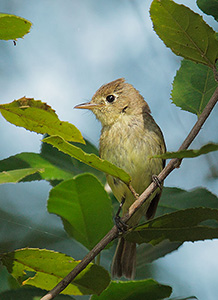 |
Pacific-slope Flycatcher
Empidonax difficilis |
|
|
STANFORD LOCATIONS: Uncommon migrant and summer resident in more heavily vegetated areas; most abundant during migration. Few pairs breed on campus, though one or two pairs can usually be found near the Mausoleum in summer. |
 |
Location |
Type |
Mating System |
Parental Care |
2ndary Diet |
Strategy |
|
|
|
|
I: 14-15 DAYS ALTRICIAL |
|
|
|
GROUND 0 - 30 feet |
|
(3-5) MONOG |
MF |
GLEAN |
| BREEDING: | Decid and conif forests and woodlands, esp near water.? broods. |
| DISPLAYS: | ? |
| NEST: | Wide variety of situations from stream bank or roots of upturned tree to eaves, cliff ledge, cavity in small tree; of moss, lichen, rootlets, grass, leaves, bark, lined with shredded bark, hair, feathers. |
| EGGS: | White to creamy, spotted with browns, occ lavender, esp near large end. 0.7" (17 mm). |
| DIET: | Also few berries and seeds. |
| CONSERVATION: | Winters from n Mexico to s Mexico. Rare cowbird host. |
| NOTES: | Often interspecifically territorial with Hammond's Flycatcher in Pacific n w. Female broods. |
| ESSAYS: | Interspecific Territoriality; Sibling Species; Birds in the Bush |
| REFERENCES: | Beaver and Baldwin, 1975; Davis et al., 1963; Johnson, 1980. |
| Help | Abbreviations | Species-Alphabetical | Species-Taxonomic | Essays-Alphabetical | |
| Except for Stanford Locations, the material in this species treatment is taken, with permission, from The Birder's Handbook (Paul Ehrlich, David Dobkin, & Darryl Wheye, Simon & Schuster, NY. 1988). | |||||